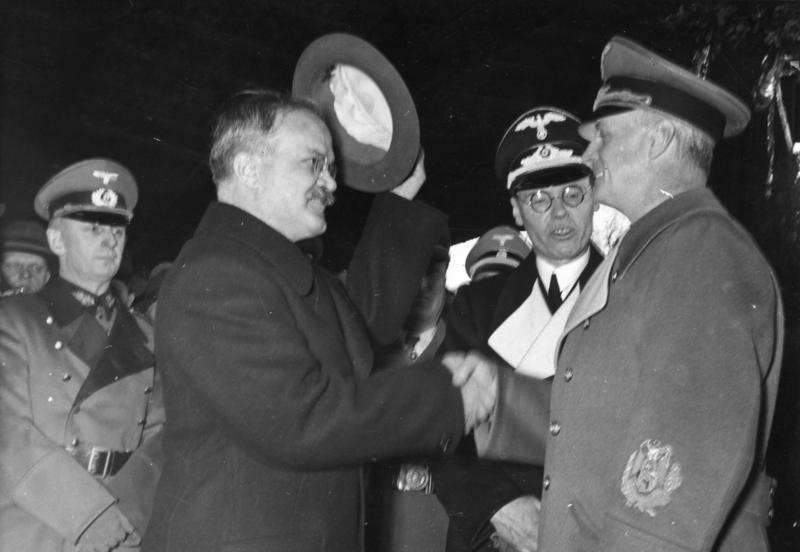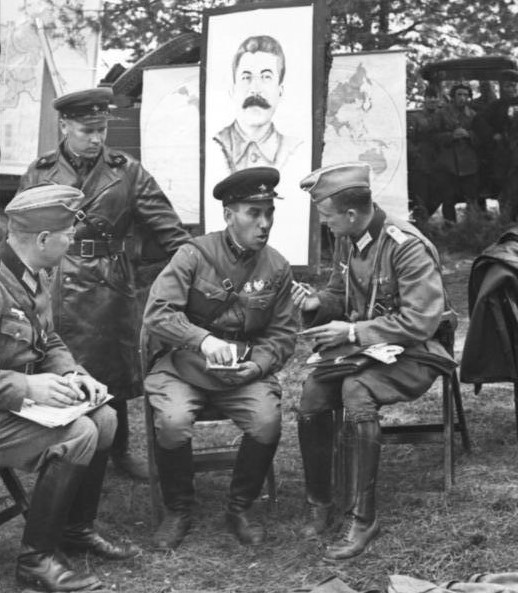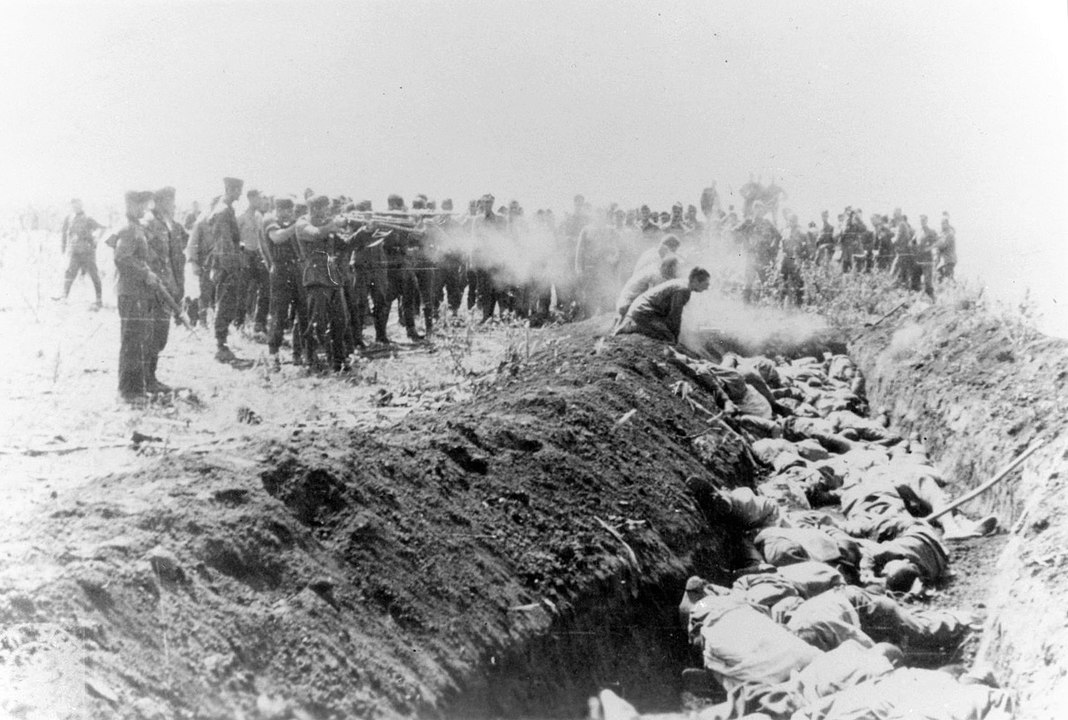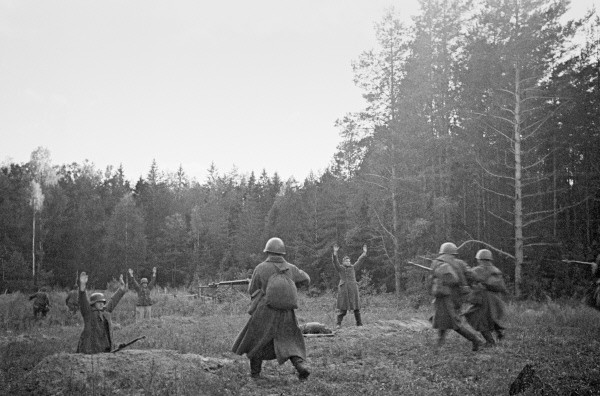Soviet Foreign Minister Vyacheslav Molotov disembarked from his private train car in a somber Berlin on the rainy morning of November 12, 1940. A German band struck up the Internationale, but at twice the normal speed—Nazi Party officials were worried that some locals might try to sing along to the socialist anthem. Molotov and his party were then whisked away in Mercedes limousines down empty streets to meetings with German leadership.

By the time of Molotov’s visit, the Soviet Union and Nazi Germany had been partners for over a year. Between September 1939 and May 1940, Germany had succeeded in overrunning much of Central and Western Europe, most shockingly its rapid victory over France. The USSR, in turn, had conquered the Baltic States, Romanian Bessarabia, Finnish Karelia, and Eastern Poland. Between them, Hitler and Stalin now held sway over almost all of Europe. Only Great Britain remained defiant, having bested the Luftwaffe in the skies over their island home.
Despite their mutual ill-gotten gains, the Soviet-German Pact was an uneasy partnership. Growing tensions over Finland and the Balkans, Soviet-German trade, and the seemingly anti-Soviet Tripartite Pact between Italy, Japan, and Germany all cast a shadow over the Soviet-German relationship.
As trust frayed, Hitler had invited Stalin to send Molotov to Berlin. As he told his senior military personnel, he intended to sound out Soviet intentions. He had already ordered the Luftwaffe to conduct reconnaissance flights over Soviet border defenses and had the Wehrmacht running secret wargames with the USSR as an adversary. But Hitler had not yet decided to attack the Soviet Union.

German and Soviet officers converse in the jointly occupied Polish city of Brest, 1939.
For three days in November, Molotov met with German Foreign Minister Ribbentrop and the Fuhrer. Hitler was expansive in his proposals; as German documents recorded, he wanted “to establish the spheres of influence between Russia, Germany, Italy and Japan along very broad lines,” which would mean working together to partition the British Empire. Molotov responded by demanding Germany address existing Soviet grievances first.
Following a disastrous dinner party at the Soviet embassy—British bombers drove attendees into a basement bomb shelter—Molotov left Berlin empty-handed. A few weeks later, the Soviets sent a démarche to Berlin indicating a long list of demands required for Soviet membership in the Tripartite Pact. The list was far too expansive for Hitler. The Germans never replied.
Instead, on December 18, Hitler issued OKW Directive No. 21, which declared: “The German Armed Forces must be prepared to crush Soviet Russia in a quick campaign (Operation Barbarossa) even before the conclusion of the war against England.” He rejected Wehrmacht suggestions that new states be carved out of the Soviet Union, instead making clear that “the Jewish-Bolshevik intelligentsia, the previous ‘oppressor’ of the people,” was to be eliminated.

The destruction of the USSR and the enslavement or murder of 220 million people would create the space for the Lebensraum (living space) Hitler had long argued was necessary for Germany to be a great power. Hitler further believed a rapid defeat of the USSR would convince Great Britain to negotiate an end to the war in the West.
In the early morning hours of June 22, 1941, the Germans struck. They and their allies had mustered nearly 3.7 million men, 3,350 tanks, and nearly 3,000 aircraft, organized into three vast Army Groups. Their targets were Leningrad, Moscow, and Ukraine, respectively. At 3:15 am, German artillery began to pound Soviet border positions. Shortly thereafter, Luftwaffe bombers struck Soviet airfields, destroying up to 40 percent of Soviet front-line air strength in a few hours. Soviet planes were lined up neatly on their airfields, making them easy targets.
Stalin and the Red Army had been caught by surprise. While the possibility of a German invasion was considered real, Stalin did not believe Hitler would strike while still fighting Great Britain in the West. He was also certain that the German buildup along Soviet borders was a negotiating tactic in ongoing trade talks.
The Red Army, for its part, was in parlous shape and unprepared for war. Stalin had purged the senior ranks of the Red Army for political reasons between 1936 and 1941, killing, imprisoning, or dismissing more than 25,000 senior officers.
Simultaneously, the Red Army had been ordered to triple in size. To fill out the huge numbers of empty positions created by expansion and the simultaneous purges, officers were rushed into commission; in 1941, only half had completed any formal military education program.

A Soviet war poster from 1941 (left). A Soviet junior political officer urges Soviet troops forward against German positions, 1942 (right).
Facing this largely amateur mass army were experienced German forces, honed in war since 1936. Using their superior experience, mobility, and communications, fast-moving German armored forces cut off entire Soviet armies in the opening weeks of the war, creating a series of gigantic kesselschlachten (cauldron battles).
Surrounded and subjected to constant aerial and artillery bombardment, these “cauldron battles” witnessed the annihilation of hundreds of thousands of Soviet soldiers. The Soviet Union suffered an average of 46,000 casualties a day during the first six weeks of the war.
Nevertheless, the Germans had underestimated the strength of Soviet resistance. Further, atrocities committed by German Einsatzgruppen behind the lines alienated local populations, some of which had at first greeted the Germans as liberators. As resistance grew in the German rear and Hitler redirected forces elsewhere, the central thrust of the German advance towards Moscow slowed.

Mass execution of Soviet civilians carried out by a German Einsatzgruppen unit in 1941.
By early December, exhausted German forces managed to reach the end stops on the Moscow tram system. But temperatures had plunged to 40 degrees below zero. Unprepared German forces lacked winter clothing and equipment and were outfought by Soviet forces defending the capital. In mid-December, the Red Army launched a ferocious counterattack, nearly triggering a complete German collapse. The lines eventually stabilized a hundred miles west of the Soviet capital.
The Soviet-German front that opened with Operation Barbarossa proved to be the decisive theater of the Second World War. Eighty-two percent of German military casualties occurred on the Eastern Front. Over the next four years, nearly ten percent of Germany’s prewar population and a staggering 16 percent of the USSR’s would die, mostly in the titanic struggle between Hitler and Stalin.
While it is important to acknowledge Stalin’s role in the outbreak of the war and the nature of the Soviet regime, it is vital to recognize the price paid by Soviet men and women in derailing Barbarossa, and eventually, defeating Germany.

German soldiers surrender to Red Army units near Vitovka on the Bryansk Front, 1941.
On the anniversary of the German invasion, it is worth remembering that Soviet soldiers—more than any other—were responsible for Hitler’s final defeat.
Learn more about Operation Barbarossa
David Stahel, Operation Barbarossa and Germany’s Defeat in the East. Cambridge: Cambridge University Press, 2009.
Craig W.H. Luther, The First Day on the Eastern Front: Germany Invades the Soviet Union, June 22, 1941. Guilford, CT: Stackpole, 2018
English-Language Primary Sources on Operation Barbarossa
Gottlob Biderman, In Deadly Combat: A German Soldier’s Memoir of the Eastern Front. Lawrence, KS: University Press of Kansas, 2000.
A.V. Gorbatov, Years Off My Life; The Memoirs of a General of the Soviet Army. Constable Press, 1965.
Learn more about the Eastern Front:
David Glantz and Jonathan M. House, When Titans Clashed: How the Red Army Stopped Hitler. Lawrence, KS: University Press of Kansas, 2015.
Chris Bellamy, Absolute War: Soviet Russia in the Second World War. New York: Knopf Doubleday, 2008.
